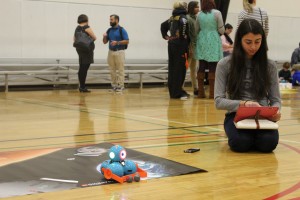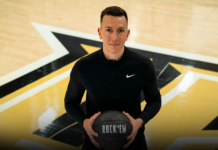Meet the future global leaders with knowledge expertise in science, technology and math—elementary school-aged children.
The UCF College of Education and Human Performance hosted its first Hour of Code event on Tuesday Dec. 8, 2015, where children and adults operated robotics using coding concepts simply from their smartphone devices and tablets.
The event, held during Computer Science Education Week, was part of a current research study being performed by UCF education professor and educational researcher, Dr. Megan Nickels.
The research study focuses on how students with terminal illnesses can learn mathematics through computer science.
Several of the children that intended the event and demonstrated coding practices in front of the audience were students Nickels works with currently from Florida Hospital. Other students at the Hour of Code event were visiting from the Galileo School for Gifted Learning.

One of Nickels’ responsibilities involves going into hospitals with Dash and Dot robots, invented by Wonder Workshop, and Lego Mindstorms EV3 robotic kits to supplement the learning processes of coding with children who have terminal illnesses.
“I take those (robots) in and I give them authentic, meaningful experiences so I can help keep them (students) on track with their academics in non-traditional settings,” Nickels said.
Nickels first opened her speech at Hour of Code by mentioning that we live in a world driven by computer science and that the trend is only going to increase.
“Computer science hasn’t made its way into schools in the way that it should,” Nickels said. “As part of the college of education, it is our job to prepare future teachers.”
Nickels said the goal behind the event was making the initial introduction to computer science and being engaging in the ways that it introduces concepts through robotics or Star Wars-themed, coding module activities.
Part of the coding process involves applications of mathematics to help students learn. For example, for a Dash or Dot robot to make a 90-degree turn, the user must be knowledgeable in angles and geometry basics. Programming the robot can range from using simple to complex mathematical applications.
Several of Nickels’ undergraduate students, who are members of the registered organization known as (pig-e) Pediatric Interest Group Education were at the event volunteering and assisting children with operating the Dash and Dot robots through obstacle courses set upon the floor of the education building’s gymnasium.
Savannah Stephenson, an elementary education major, said there are various apps to use with the robots to match with different age groups and learning abilities among the students.
“It gives you that visual kinesthetic hands-on learning approach to mathematics that you don’t usually have,” she said.
Stephenson said that it is incredible to have children see their own displays of work whether it’s coding or having the robot work on different activities.
“Not everything is handed to you; people create these things,” Stephenson said. “You can be one of those people. You can make your mark on this world and create something that no one’s ever seen before, which inspires them (students) to get involved whether it’s in technological or computer science fields. They can apply this knowledge to anything to be able to synthesize something new for the world.”






